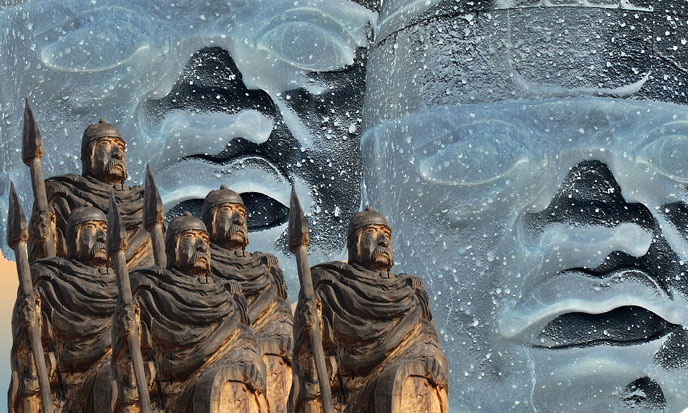The word “Viking” is simply an Old Norse word for pirate or sea warrior and in movies as well as series; they are usually depicted as formidable Caucasians.
Old Norse was a North Germanic language once spoken in Scandinavia, the Faroe Islands, Iceland, Greenland, and in parts of Russia, France and the British Isles and Ireland. It was the language of the Vikings or Norsemen.
According to theconversation.com, the word “Viking” entered the Modern English language in 1807, at a time of growing nationalism and empire building.
“During the 19th century, Vikings were praised as prototypes and ancestor figures for European colonists. The idea took root of a Germanic master race, fed by crude scientific theories and nurtured by Nazi ideology in the 1930s. These theories have long been debunked, although the notion of the ethnic purity of the Vikings still seems to have popular appeal – and it is embraced by white supremacists,” the site added.
While Scandinavians from the ninth to the 11th centuries are associated with the word Viking in contemporary culture birthing terms like “Viking blood”, “Viking DNA” and “Viking ancestors”, it betrays the mobility of the Viking who traveled around foreign lands while the bulk of the Scandinavian population stayed at home.
While the Vikings were raiding lands beyond the boundaries of modern Europe, modern nation states of Denmark, Norway and Sweden were still undergoing formation.

But since the vision of a Viking world depends on contemporary digital and filmic popular culture — such as the TV show Vikings and Viking-adjacent video games enabling chatter from white supremacists about medieval references of keeping their blood ‘untainted’, what is the right historical make-up of the Vikings?
Time.com reports: “As Stefan Brink and Neil Price’s The Viking World describes, historically, it referred to seafaring groups who traversed the seas, oceans and rivers to raid, trade and colonize around the 10th and 11th centuries. They established settler colonies across the Mediterranean, Caspian, Black, Arctic and North Atlantic seas and waterways, maintaining a presence in regions ranging from present-day Russia and Europe to the Americas. Crucially, they were not homogeneous seafarers as is often imagined; they were multicultural and multiracial. But until recently, scholarly discussions of the Vikings in relation to race and a Global Middle Ages had been sidelined.”
The white supremacists narrative of the Vikings origins is blamed on the Germans who sought to justify their persecution of targeted groups.

“In the 19th century, Romantic German nationalism metastasized into the Völkish movement, which was interested in historical narratives that bolstered a white German nation state. The movement rewrote history, drawing on folklore such as that of Brothers Grimm, medieval epics and a dedication to racial white supremacy,” Time adds.
The mobility of the early Vikings help extended their trade routes from Canada to Afghanistan embracing and adapting influences from a wide range of cultures from Christian Irish in the west or the Muslims of the Abbasid Caliphate in the east.
Another theory also holds that the original Scandinavians were Africans who migrated there from the region of the Nile Valley comprising tall Africans known as (Bantu) and their short counterparts called (Twa) which served as the basis for the Norse mythology of giants and dwarves.

Theafricansindiaspora.com reports: “Tacitus wrote about the Celts and described them as Black in 80 A.D. as well as Ephorus in 405 B.C. who claimed they were Black. On mainland Europe, they were called Iberians, over a period of time the Europeans would adopt the name. The original Vikings or Danes were Black, this is clear in the Oseberg 8th century Vikings on the Norway sledge carving of the Black seafarers that populated the region at this time. It is very clear from this carving that the 8th century Vikings were different from the blonde-haired blue-eyed big-bodied version of Viking legends. Africans who came from the Iberian Peninsula gradually colonized all of Europe as far as the Urals. This assertion is found in the writings of Fabre d’Olivet. “Central Europe was populated by Blacks, skilled in handling large javelins of which the white Gaul’s would later be known for. Further evidence can be found in the writings of David MacRitchie.”
This account holds that Blacks in ancient times came to Britain from Spain, Arabia Felix, Egypt, West Africa, India, Persia and what is today named Denmark.
According to the site, Viking warriors were known as Berserkers known for their fierceness and boldness, Black shamans who went into altered states before going into battle. The Norse Vikings who invaded England were described in chronicles as Black Men. The Black Vikings raided Iona, Ireland in 795, In 852 they would attack the city of Athcliath, (modern-day Dublin). In 867 the Black Norseman would take the city of York and establish a permanent presence in England. In 1018 the Norseman who arrived in Kiev, Russia were described as Danes. “The Danes then were like Moors- Black like them too- David MacRitchie- Ancient and Modern Britons volume 1 pg 121. Author William Gershom Collingwood describes the invading horde in his book “Scandinavian Britain” as Swart-Black and Gold Adorned.










